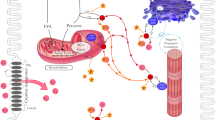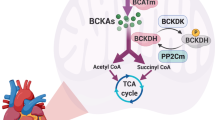Abstract
Carnitine is a naturally occurring compound that is essential in energy metabolism of the mammalian heart. In addition to its essential role in facilitating ß-oxidation, carnitine eliminates excess toxic acyl residues and regulates the mitochondrial acetyl coenzyme A (CoA)/CoA ratio. Thus, it is not surprising that patients with carnitine deficiency syndromes exhibit defects in energy metabolism and in some cases demonstrate left ventricular dysfunction. Pivalic acid is commonly used to create prodrugs, such as pivampicillin and pivmecillinam, to facilitate enteral absorption and increase oral bioavailability. Pivalic acid released from the drug following absorption readily forms an ester with carnitine, which is then excreted as pivaloylcarnitine. Sustained loss of carnitine in the form of this ester induces a state of carnitine deficiency, exemplified by low plasma and tissue carnitine content. This review examines the effects in the rat of short- and long-term sodium pivalate treatment on: (1) cardiac carnitine content; (2) in vitro mechanical function; (3) markers of glycolytic and fatty acid metabolism; and (4) energy substrate metabolism. Treatment with sodium pivalate induces a gradual loss of cardiac carnitine content for up to 12 weeks. Doubling the duration of treatment is not associated with any further decrease in cardiac carnitine content. While heart function following short-term treatment (2 weeks) is normal under aerobic conditions, impaired recovery of function following ischaemia is seen. In contrast, long-term treatment (11–28 weeks) is associated with impaired heart function, which is dependent on workload and substrate availability. Impaired heart function is also associated with reductions in activity of 3-hydroxyacyl CoA dehydrogenase and rates of fatty acid oxidation. However, to maintain adenosine triphosphate production, glucose metabolism, expressed as hexokinase activity and glucose oxidation, is increased in carnitine-deficient hearts. Hearts from sodium pivalate-treated animals demonstrate a cardiomyopathy that is dependent on duration of treatment, workload and substrate supply. This model of hypocarnitinaemia may thus be useful to study the metabolic and cardiac consequences of carnitine-deficiency syndromes.




Similar content being viewed by others
References
Bremer J. Carnitine: metabolism and functions. Physiol Rev 1983; 63: 1421–80
Stanley WC, Recchia FA, Lopaschuk GD. Myocardial substrate metabolism in the normal and failing heart. Physiol Rev 2005; 85: 1093–129
Winter SC, Buist NR. Cardiomyopathy in childhood, mitochondrial dysfunction, and the role of L-carnitine. Am Heart J 2000; 139: S63–9
Tripp ME, Katcher ML, Peters HA, et al. Systemic carnitine deficiency presenting as familial endocardial fibroelastosis. N Engl J Med 1981; 305: 385–90
Waber LJ, Valle D, Neill C, et al. Carnitine deficiency presenting as familial cardiomyopathy: a treatable defect in carnitine transport. J Pediatr 1982; 101: 700–5
Bennett MJ, Hale DE, Pollitt RJ, et al. Endocardial fibroelastosis and primary carnitine deficiency due to a defect in the plasma membrane carnitine transport. Clin Cardiol 1996; 19: 243–6
Zales VR, Benson Jr DW. Reversible cardiomyopathy due to carnitine deficiency from renal tubular wasting. Pediatr Cardiol 1995; 16: 288–92
Glasgow AM, Engel AG, Bier DM, et al. Hypoglycemia, hepatic dysfunction, muscle weakness, cardiomyopathy, free carnitine deficiency and long-chain acylcarnitine excess responsive to medium chain triglyceride diet. Pediatr Res 1983; 17: 319–26
Prockop LD, Engel WK, Shug AL. Nearly fatal muscle carnitine deficiency with full recovery after replacement therapy. Neurology 1983; 33: 1629–31
Lysiak W, Lilly K, Toth PP, et al. Effect of concentration of carnitine on acetylcarnitine production in rat heart mitochondria oxidizing pyruvate. Nutrition 1988; 4: 215–9
Broderick TL, Quinney HA, Lopaschuk GD. Carnitine stimulation of glucose oxidation in the fatty acid-perfused isolated working rat heart. J Biol Chem 1992; 267: 3758–63
Holme E, Jodal U, Linstedt S, et al. Effects of pivalic acid-containing prodrugs on carnitine homeostasis and on response to fasting in children. Scand J Clin Lab Invest 1992; 52: 361–72
Rose SJ, Stokes TC, Patel S, et al. Carnitine deficiency associated with long-term pivampicillin treatment: the effect of a replacement therapy regime. Postgrad Med J 1992; 68: 932–4
Abrahamsson K, Eriksson BO, Holme E, et al. Impaired ketogenesis in carnitine depletion caused by short-term administration of pivalic acid prodrug. Biochem Med Metab Biol 1994; 52: 18–21
Holme E, Jacobson CE, Nordin I. Carnitine deficiency induced by pivampicillin and pivmecillinam therapy. Lancet 1989; II: 469–72
Brass EP, Mayer MD, Mulford DJ, et al. Impact on carnitine homeostasis of short-term treatment with pivalate prodrug cefditoren pivoxil. Clin Pharmacol Ther 2003; 73: 338–47
Brass EP. Pivalate-generating prodrugs and carnitine homeostasis in man. Pharmacol Rev 2002; 54: 589–98
Rebouche CJ, Paulson DJ. Carnitine metabolism and functions in humans. Annu Rev Nutr 1986; 6: 41–66
Breningstall GN. Carnitine deficiency syndromes. Pediatr Neurol 1980; 6: 75–81
DeVivo DC, Tein I. Primary and secondary disorders of carnitine metabolism. Int Ped 1990; 5: 134–41
Rebouche CJ, Engel AG. Carnitine metabolism and deficiency syndromes. Mayo Clin Proc 1983; 58: 533–40
Tanphaichitr V, Leelehagul P. Carnitine metabolism and human carnitine deficiency. Nutrition 1993; 9: 246–54
Angelini C, Vergani L, Martinuzzi A. Clinical and biochemical aspects of carnitine deficiency and insufficiency: transport defects and inborn errors of b-oxidation. Crit Rev Clin Lab Sci 1992; 29: 217–42
Stanley CA. Carnitine deficiency disorders in children. Ann N Y Acad Sci 2004; 1033: 42–51
Stanley CA. Carnitine disorders. Adv Pediatr 1995; 42: 209–42
Kerner J, Hoppel C. Genetic disorders of carnitine metabolism and their nutritional management. Annu Rev Nutr 1998; 18: 179–206
Melegh B, Kerner J, Bieber LL. Pivampicillin-promoted excretion of pivaloylcarnitine in humans. Biochem Pharmacol 1987; 36: 3405–9
Abrahamsson K, Mellander M, Eriksson BO, et al. Transient reduction of human left ventricular mass in carnitine depletion induced by antibiotics containing pivalic acid. Br Heart J 1995; 74: 656–9
Holme E, Greter J, Jacobson CE, et al. Carnitine deficiency induced by pivampicillin and pivmecillinam therapy. Lancet 1989; 8661: 469–73
Melegh B, Pap M, Molnar D, et al. Carnitine administration ameliorates the changes in energy metabolism caused by short-term pivampicillin medication. Eur J Pediatr 1997; 156: 795–9
Bianchi PB, Davis AT. Sodium pivalate treatment reduces tissue carnitines and enhances ketosis in rats. J Nutr 1991; 121: 2029–36
Nelson HK, Lauber RP, Sheard NF. Effect of various levels of supplementation with sodium pivalate on tissue carnitine concentrations and urinary excretion of carnitine in the rat. J Nutr Biochem 2001; 12: 242–50
Broderick TL, Cifuentes J, Green D, et al. Short-term carnitine deficiency does not alter aerobic heart function but depresses reperfusion recovery after ischemia. Can J Physiol Pharmacol 2001; 79: 892–7
McGarry JD, Foster DW. An improved and simplified radioisotopic assay for the determination of free and esterified carnitine. J Lipid Res 1976; 17: 277–81
Morris GS, Zhou Q, Wolf BA, et al. Sodium pivalate reduces cardiac carnitine content and increases glucose oxidation with-out affecting cardiac functional capacity. Life Sci 1995; 57: 2237–44
Broderick TL, Wolf BA, Christos SC, et al. Fatty acid oxidation and cardiac function in the sodium pivalate model of secondary carnitine deficiency. Metabolism 1995; 44: 499–505
Broderick TL, DiDomenico D, Shug AL, et al. L-propionyl-carnitine effects on cardiac carnitine content and function in secondary carnitine deficiency. Can J Physiol Pharmacol 1995; 73: 509–14
Broderick TL, Panagakis G, DiDomenico D, et al. L-Carnitine improvement of cardiac function is associated with a stimulation in glucose but not fatty acid metabolism in carnitine-deficient hearts. Cardiovasc Res 1995; 30: 815–20
Effron MB, Bhatnagar GM, Spurgeon HA, et al. Changes in myosin isoenzymes, ATPase activity, and contraction duration in rat cardiac muscle with aging can be modulated by thyroxine. Circ Res 1987; 60: 238–45
Malhotra A, Mordes JP, McDermott L, et al. Abnormal cardiac biochemistry in spontaneously diabetic Bio-Breeding/Worcester rat. Am J Physiol 1985; 249: H1051–5
Tamai I, Yabuuchi H, Nezu J, et al. Cloning and characterization of a novel human pH-dependent organic cation transporter, OCTN1. FEBS Lett 1997; 419: 107–11
Tamai I, Ohashi R, Nezu J, et al. Molecular and functional identification of sodium ion-dependent, high affinity human carnitine transporter OCTN2. J Biol Chem 1998; 273: 20378–82
Okudaira N, Fujigaki M, Nakayoshi T, et al. Up-regulation of carnitine transporters helps maintain tissue carnitine levels in carnitine deficiency induced by pivalic acid. Pharm Res 2001; 18: 439–45
Tein I. Carnitine transport: pathophysiology and metabolism of known molecular effects. J Inherit Metab Dis 2003; 26: 147–69
Rebouche CJ. Kinetics, pharmacokinetics, and regulation of L-carnitine and acetyl-L-carnitine metabolism. Ann N Y Acad Sci 2004; 1033: 30–41
Saddik M, Gamble J, Witters LA, et al. Acetyl CoA carboxylase regulation of fatty acid oxidation in the heart. J Biol Chem 1993; 268: 25836–45
Paulson DJ, Shug AL. Tissue specific depletion of L-carnitine in rat heart and skeletal muscle by D-carnitine. Life Sci 1981; 28: 2931–8
Heinonen OJ, Takala J. Carnitine status during prolonged total parenteral nutrition. J Pediatr 1993; 122: 503–4
Tsoko M, Beauseigneur F, Gresti J, et al. Enhancement of activities relative to fatty acid oxidation in the liver of rats depleted of L-carnitine by D-carnitine and a gamma-butyrobetaine hydroxylase inhibitor. Biochem Pharmacol 1995; 49: 1403–10
Wennberg A, Hyltander A, Sjöberg Å, et al. Prevalence of carnitine depletion in critically ill patients with undernutrition. Metabolism 1992; 41: 165–71
Zaugg CE, Spaniol M, Kaufmann P, et al. Myocardial function and energy production in carnitine-deficient rats. Cell Mol Life Sci 2003; 60: 767–75
El Alaoui-Talibi Z, Landormy S, Loireau A, et al. Fatty acid oxidation and mechanical performance of volume-overloaded rat hearts. Am J Physiol Heart Circ Physiol 1992; 262: H1068–74
Whitmer JT. L-carnitine treatment improves cardiac performance and restores high energy phosphate pools in cardiomyopathic Syrian hamster. Circ Res 1987; 61: 396–408
Horiuchi M, Yoshida H, Kobayashi K, et al. Cardiac hypertrophy in juvenile visceral steatosis (jvs) mice with systemic carnitine deficiency. FEBS Lett 1993; 326: 267–71
Broderick TL, Quinney HA, Lopaschuk GD. L-carnitine increases glucose oxidation and mechanical recovery in ischemic diabetic rat heart. Cardiovasc Res 1995; 29: 373–8
Regitz V, Bossaller C, Strasser R, et al. Metabolic alterations in end-stage and less severe heart failure — myocardial carnitine decrease. J Clin Chem Clin Biochem 1990; 28: 611–7
Lanza-Jacoby S, Reibel DK. Changes in tissue levels of carnitine during E. coli sepsis in the rat. Circ Shock 1988; 24: 29–34
Broderick TL, Quinney HA, Barker CC, et al. Beneficial effect of carnitine on mechanical recovery of rat hearts reperfused after a transient period of global ischemia is accompanied by a stimulation of glucose oxidation. Circulation 1993; 87: 972–81
Paulson DJ. Carnitine deficiency-induced cardiomyopathy. Mol Cell Biochem 1988; 180: 33–41
Acknowledgements
The author has no financial interests or other conflicts of interest directly relevant to the contents of this study.
Author information
Authors and Affiliations
Corresponding author
Rights and permissions
About this article
Cite this article
Broderick, T.L. Hypocarnitinaemia Induced by Sodium Pivalate in the Rat is Associated with Left Ventricular Dysfunction and Impaired Energy Metabolism. Drugs R D 7, 153–161 (2006). https://doi.org/10.2165/00126839-200607030-00002
Published:
Issue Date:
DOI: https://doi.org/10.2165/00126839-200607030-00002




